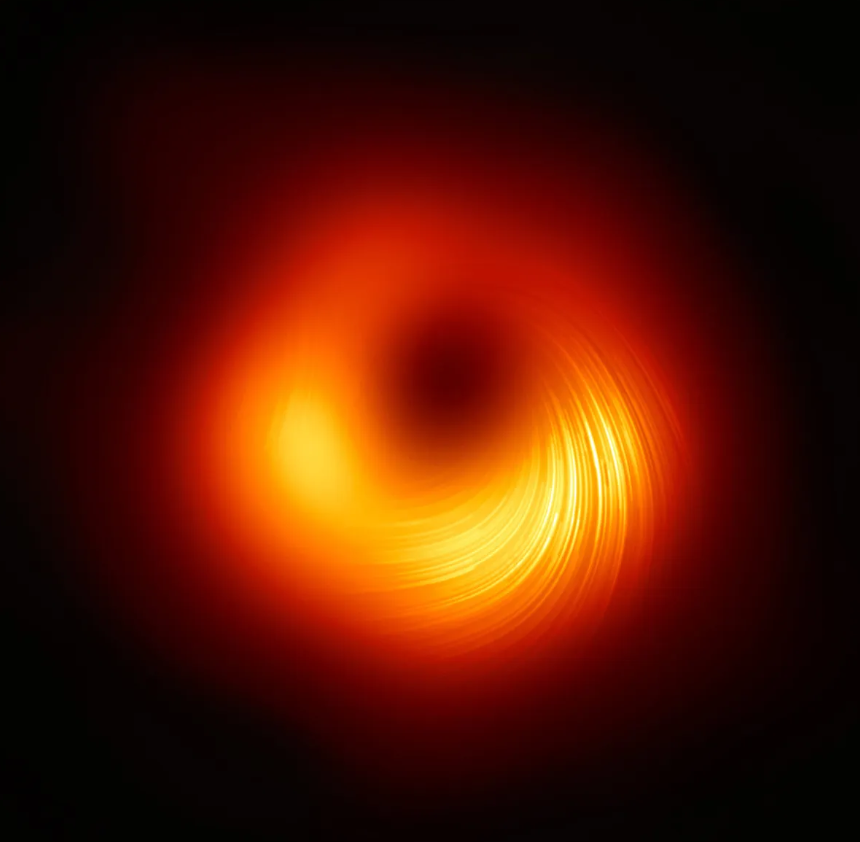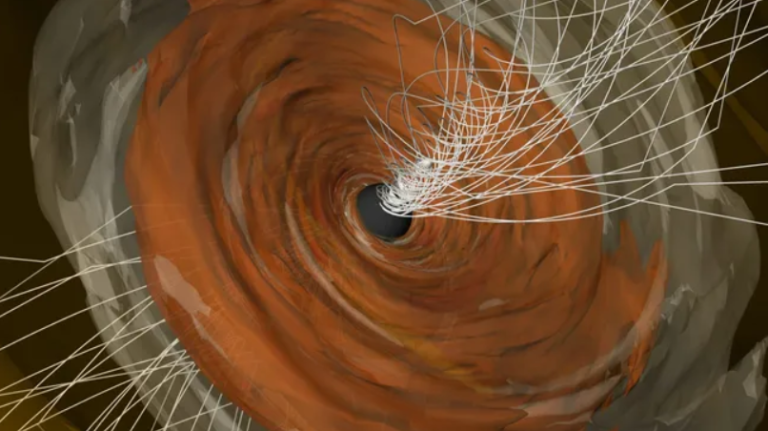Scientists Delighted by Twisted Magnetic Fields in the First Black Hole Ever Imaged by Humans
The groundbreaking observations made by the Event Horizon Telescope are enabling us to address enduring inquiries regarding the process by which black holes consume matter.
The swirling light on the periphery of a distant supermassive black hole might facilitate the escape of matter from being engulfed by this cosmic behemoth.
Known as M87*, the supermassive black hole at the center of M87 boasts a mass equivalent to around 6.5 billion suns. It gained widespread attention in 2019 when the Event Horizon Telescope (EHT) captured the first-ever image of M87*, providing humanity with a glimpse of the surroundings of a black hole.
Now, the EHT Collaboration, responsible for this historic image, has developed a model illustrating how the electric fields of light rotate around the supermassive black hole, situated approximately 54 million light-years away from Earth. This polarized light, characterized by waves vibrating on a single plane, carries crucial information about the magnetic field and the particles accelerated to near-light speeds around the black hole.
Scientists propose that these magnetic fields may prevent M87’s colossal black hole from consuming matter, instead propelling it into space as highly collimated (or parallel) jets, ejecting at nearly the speed of light. The perpetually revolving light around M87* is also referred to as circular polarization.
Andrew Chael, study co-author and project coordinator at Princeton University, commented on the significance of circular polarization, stating, “Circular polarization is the final signal we looked for in the EHT’s first observations of the M87 black hole, and it (the polarization) was by far the hardest to analyze.”
Chael added, “These new results give us confidence that our picture of a strong magnetic field permeating the hot gas surrounding the black hole is the right one.” He emphasized that the unprecedented observations by EHT are providing answers to longstanding questions about how black holes consume matter and launch jets beyond their host galaxies.
In 2021, two years after the release of the initial image, the EHT Collaboration unveiled a second striking image, revealing polarized light around a black hole for the first time. This polarized light has a distinct orientation and brightness compared to unpolarized light. The 2021 data also disclosed the direction of oscillating electric fields, offering the initial indication that magnetic fields around M87* are both robust and well-organized.
To delve deeper into these findings, researchers utilized the Atacama Large Millimeter/submillimeter Array (ALMA) in Northern Chile. ALMA, with its 66 antennas in the Chilean desert, served as a reference antenna for the EHT, providing calibration. This array has the capability to peer through cosmic dusty environments, such as those surrounding black holes, to explore longer wavelengths of light.

ALMA participates in a global network of radio telescopes forming the Event Horizon Telescope (EHT), creating a virtual instrument equivalent to the size of Earth through a technique known as very long baseline interferometry (VLBI).
A recent analysis of the 2017 ALMA data illustrates the twisting of electric fields of light in a linear direction, reaffirming the presence of robust magnetic fields observed in 2021. According to computer simulations by EHT scientists, these formidable magnetic fields act as a counterforce against matter approaching M87*. Additionally, these magnetic fields propel jets of matter away from M87* at velocities approaching the speed of light, preceding the matter’s passage through the black hole’s event horizon—the point beyond which nothing, not even light, can escape. This process contributes to the already immense mass of the black hole. It is noteworthy that while the EHT cannot directly image black holes, as they emit no light, the surrounding areas of each black hole emit detectable radiation.
The researchers are diligently scrutinizing the data for more robust evidence of linear polarization, acknowledging that their work may “still leave room for improvement,” as stated by Hugo Messias, a study co-author leading the VLBI team at ALMA. Messias expressed optimism about ongoing advancements in EHT’s observational capabilities, suggesting that continued analysis will likely unveil further insights into the mysteries surrounding M87*.
The collaborative efforts of the EHT, credited collectively as the first author in the new findings, are comprehensively detailed in a paper published on Wednesday, November 8, in the Astrophysical Journal.
This article is republished from SpaceCom under a Creative Commons license. Read the original article.
Do not forget to share your opinion with us to provide you with the best posts !





0 Comments